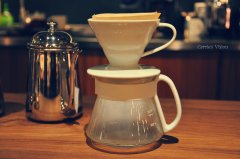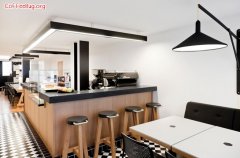Philharmonic pressure Coffee utensils A brand-new instrument for making coffee.

Aero Press is a simple instrument for making coffee by hand. Overall, its structure is similar to that of a syringe. When in use, put ground coffee and hot water in its "syringe", then press the putter, and the coffee will flow into the container through the filter paper. It combines the immersion quenching method of the French filter pressure pot, the filter paper filtration of the follicular coffee, and the fast, pressure quenching principle of the Italian coffee. The coffee brewed by Philadelphia has the richness of Italian coffee, the purity of brewed coffee, and the smoothness of French pressure. By changing the size and pressing speed of coffee grinding particles, users can cook different flavors according to their own preferences. In addition to being fast, convenient and effective, its cleaning and maintenance is surprisingly simple-it takes only a few seconds after use. The Philharmonic pressure also has the advantages of short size, light weight and not easy to damage, so it is quite suitable to be used as a coffee brewing apparatus for going out.
AeroPress is a new coffee making appliance launched by Alan Adler, an inventor / engineer of AIRPOBIE Company, in 2006. He conducted numerous brewing experiments and used laboratory instruments to measure records. Experiments have shown that proper temperature, contact between water and coffee, and fast filtration are the key to the excellent taste of coffee. He designed and tested dozens of other cooking utensils before inventing Philharmonic pressure. Coffee lovers use a beta version at home to further verify the design of Philharmonic pressure.
Philharmonic pressure has been sought after by coffee lovers around the world as soon as it came out. Until now, there is a World Philharmonic pressure Competition every year, which is a competition to use Philharmonic pressure to make coffee. There are a lot of users and cafes using Philharmonic pressure in Europe and the United States, which is already very popular. In Asia, it is also very popular to use Philharmonic pressure to make coffee in Taiwan, South Korea and Japan, and Chinese mainland fans are also on the increase in Japanese TV dramas. In 2010, Philharmonic officially entered the Chinese market and was promoted by an exclusive agent of a coffee company in Zhejiang.
Unlike the drip filter coffee machine, although the soaking time is very short, it can fully soak the coffee particles and exert soothing and gentle pressure during extraction. It draws lessons from the principle of the French press, but the coffee liquid is pressed out from the bottom of the appliance through the filter paper, and the coffee particles are finer than those required by the French press, and the contact time between coffee and water is shorter but the pressure is greater, thus ensuring that the coffee drink tastes richer and softer without a hint of bitterness. Kenny Kenneth Davids, a famous American coffee reviewer and author of several coffee monographs, commented on "Philharmonic pressure": "if used correctly, Philharmonic pressure can make espresso and American coffee with a pure sense of export, but its price is only 20 or 1/30 of that of many household coffee machines." Eight reviewers from LOCALS ONLY COFFEE, a company in Washington State, where the coffee industry is well developed in the United States, gave the highest "five-star" rating after trial.
The characteristics of Philharmonic pressure
Why can Philharmonic pressure make mellow, smooth coffee or espresso?
Philharmonic pressure is a whole new way of making coffee.
Water and coffee powder are mixed for 10 seconds.
Then, for 20 seconds, press the mixed water and coffee powder through the filter paper with mild air pressure.
The total production time of 30 seconds makes its flavor very smooth.
From professional coffee appraiser and writer Kenneth Davids to ordinary coffee lovers praise the Philharmonic for its smoothness and richness.
Comparison between Philharmonic pressure and Italian Coffee Machine
Most coffee lovers agree that espresso is less bitter than drip coffee because of its short brewing time. However, when we do comparative tasting experiments in the homes of espresso lovers, they all think that the taste of Italian caffeine made by Philharmonic is better than that of their high-priced European espresso machines-why? The reason is that the Philharmonic pressure coffee powder is completely immersed in water and extracted at a relatively low temperature to extract a strong taste-and the lower temperature extraction is also less bitter. The temperature cannot be adjusted by the espresso machine at home. Even if it can adjust the temperature, it will not be able to extract the rich flavor at a lower temperature because of the lack of adequate contact.
In addition to the smooth taste, Philharmonic pressure has several other advantages over the traditional Italian coffee maker.
Coffee grinding is not the key to Philharmonic pressure. The Italian coffee machine requires a very high degree of grinding, and few bean grinders grind enough fine powder to make good coffee! Special Italian bean grinders are expensive and require frequent cleaning and maintenance.
Espresso experts often adjust the degree of grinding according to humidity and changes in different batches of coffee. They often have to throw it into two or three batches in order to get the cup they want.
Philharmonic pressing doesn't need powder. There are many books on espresso machines that teach the art of powder pressing, and they instruct baristas to learn the exact 30-pound pressure on the weight scale.
The Philharmonic pressure does not need to be preheated!
The Philharmonic pressure needs no maintenance. The Italian coffee machine needs regular cleaning and regular chemical descaling. The sprinkler also needs to be disassembled and cleaned regularly.
Philharmonic pressure doesn't have to decide when to stop. One of the key techniques for using an espresso machine. Espresso lovers know that novice baristas in many cafes, hotels and restaurants pump too long-causing too much sour and bitter to be extracted from coffee powder.
The amount of water used by Philharmonic pressure is mastered by users in advance, as long as the amount of water is adjusted before pressing, you can make coffee from light to strong. The comparison between the Philharmonic pressure and the French kettle people can see that the Philharmonic pressure and the French kettle have something in common, both of them achieve full contact and pressure of water and powder, but the similarities are nothing more than that.
The filter device of the kettle is at the top of the mixture. Because the coffee floats, the floating coffee powder clogs the filter, making it difficult to press and clean. Users are instructed to use coarsely ground coffee powder, which results in the degree of extraction of the coffee taste, while long soaking leads to the precipitation of bitterness.
In addition, even coarsely ground coffee has many fine particles, which pass through the filter to make the coffee bitter and rough. And these small particles continue to release bitterness. Therefore, users of the French kettle are advised to drink or pour out the coffee immediately. Some small particles are just in the filter causing great trouble for pressing and cleaning.
The coffee pressed by Philharmonic is finely filtered. Because of its purity and free of impurities, it can be preserved as a concentrated solution for several days. This concentrate can be used to make espresso, milk can be added to make lattes, or diluted to make American coffee. And the French kettle can't make espresso or lattes.
In short, cleaning the kettle is very troublesome. The Philharmonic filter cartridge is self-cleaning and it only takes 10 seconds to rinse down the pressure bar.
Food safety
The Philharmonic press is made of three kinds of plastic. The transparent filter cartridge and pressure rod are made of copolyester (copolyester). The black filter paper cover, filter paper holder, funnel and mixing rod are made of polypropylene (polypropylene/ PP). The sealing plug at the end of the pressure rod is made of thermoplastic elastomer (thermoplastic elastomer). All materials are approved by the US Food and Drug Administration (FDA) for direct contact with food. No material contains BPA, any phthalate (phthalates) or its recently exposed harmful chemicals.
There is a worldwide competition every year.
Important Notice :
前街咖啡 FrontStreet Coffee has moved to new addredd:
FrontStreet Coffee Address: 315,Donghua East Road,GuangZhou
Tel:020 38364473
- Prev

Coffee 13. Do you know how many there are? It can give you no more headaches.
Coffee is easily absorbed in the human body, but also has the role of promoting human metabolism. In addition, coffee has 13 unexpected effects in daily life. 1. A clinical trial in Illinois has found that caffeine, which slows the blood flow of blood vessels in the body, can also reduce the intensity and frequency of headaches. One of the groups is only
- Next

Craft Cafe in Paris to work in Cafe
Craft Caf, designed by French duo Pool, caters to the needs of freelancers and combines cafes with office space, setting off a new wave of co-working in cafes in Paris. Black, white and wood are the basic colors in the store, and the color considerations naturally integrate the two functions of office and coffee. St. Martin Canal in Paris
Related
- Detailed explanation of Jadeite planting Land in Panamanian Jadeite Manor introduction to the grading system of Jadeite competitive bidding, Red bid, Green bid and Rose Summer
- Story of Coffee planting in Brenka region of Costa Rica Stonehenge Manor anaerobic heavy honey treatment of flavor mouth
- What's on the barrel of Blue Mountain Coffee beans?
- Can American coffee also pull flowers? How to use hot American style to pull out a good-looking pattern?
- Can you make a cold extract with coffee beans? What is the right proportion for cold-extracted coffee formula?
- Indonesian PWN Gold Mandrine Coffee Origin Features Flavor How to Chong? Mandolin coffee is American.
- A brief introduction to the flavor characteristics of Brazilian yellow bourbon coffee beans
- What is the effect of different water quality on the flavor of cold-extracted coffee? What kind of water is best for brewing coffee?
- Why do you think of Rose Summer whenever you mention Panamanian coffee?
- Introduction to the characteristics of authentic blue mountain coffee bean producing areas? What is the CIB Coffee Authority in Jamaica?

